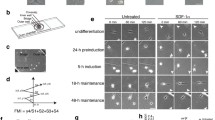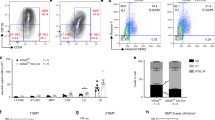Abstract
The neural cell adhesion molecule (NCAM), a key member of the immunoglobulin-like CAM family, was reported to regulate the migration of bone marrow-derived mesenchymal stem cells (BMSCs). However, the detailed cellular behaviors including lamellipodia formation in the initial step of directional migration remain largely unknown. In the present study, we reported that NCAM affects the lamellipodia formation of BMSCs. Using BMSCs from Ncam knockout mice we found that Ncam deficiency significantly impaired the migration and the directional lamellipodia formation of BMSCs. Further studies revealed that Ncam knockout decreased the activity of cofilin, an actin-cleaving protein, which was involved in directional protrusions. To explore the molecular mechanisms involved, we examined protein tyrosine phosphorylation levels in Ncam knockout BMSCs by phosphotyrosine peptide array analyses, and found that the tyrosine phosphorylation level of β1 integrin, a protein upstream of cofilin, was greatly upregulated in Ncam-deficient BMSCs. Notably, by blocking the function of β1 integrin with RGD peptide or ROCK inhibitor, the cofilin activity and directional lamellipodia formation of Ncam knockout BMSCs could be rescued. Finally, we found that the effect of NCAM on tyrosine phosphorylation of β1 integrin was independent of the fibroblast growth factor receptor. These results indicated that NCAM regulates directional lamellipodia formation of BMSCs through β1 integrin signal-mediated cofilin activity.





Similar content being viewed by others
References
Angata K, Chan D, Thibault J, Fukuda M (2004) Molecular dissection of the ST8Sia IV polysialyltransferase. Distinct domains are required for neural cell adhesion molecule recognition and polysialylation. J Biol Chem 279(24):25883–25890
Eckhardt M, Bukalo O, Chazal G, Wang L, Goridis C, Schachner M, Gerardy-Schahn R, Cremer H, Dityatev A (2000) Mice deficient in the polysialyltransferase ST8SiaIV/PST-1 allow discrimination of the roles of neural cell adhesion molecule protein and polysialic acid in neural development and synaptic plasticity. J Neurosci 20(14):5234–5244
Weinhold B, Seidenfaden R, Röckle I, Mühlenhoff M, Schertzinger F, Conzelmann S, Marth JD, Gerardy-Schahn R, Hildebrandt H (2005) Genetic ablation of polysialic acid causes severe neurodevelopmental defects rescued by deletion of the neural cell adhesion molecule. J Biol Chem 280(52):42971–42977
Hansen SM, Berezin V, Bock E (2008) Signaling mechanisms of neurite outgrowth induced by the cell adhesion molecules NCAM and N-cadherin. Cell Mol Life Sci 65(23):3809–3821
Beggs HE, Baragona SC, Hemperly JJ, Maness PF (1997) NCAM140 interacts with the focal adhesion kinase p125(fak) and the SRC-related tyrosine kinase p59(fyn). J Biol Chem 272(13):8310–8319
Francavilla C, Cattaneo P, Berezin V, Bock E, Ami D, de Marco A, Christofori G, Cavallaro U (2009) The binding of NCAM to FGFR1 induces a specific cellular response mediated by receptor trafficking. J Cell Biol 187(7):1101–1116
Kolkova K, Novitskaya V, Pedersen N, Berezin V, Bock E (2000) Neural cell adhesion molecule-stimulated neurite outgrowth depends on activation of protein kinase C and the Ras-mitogen-activated protein kinase pathway. J Neurosci 20(6):2238–2246
Cavallaro U, Christofori G (2004) Multitasking in tumor progression: signaling functions of cell adhesion molecules. Ann N Y Acad Sci 1014:58–66
Pittenger MF, Mackay AM, Beck SC, Jaiswal RK, Douglas R, Mosca JD, Moorman MA, Simonetti DW, Craig S, Marshak DR (1999) Multilineage potential of adult human mesenchymal stem cells. Science 284(5411):143–147
Shi Y, Liu R, Zhang S, Xia YY, Yang HJ, Guo K, Zeng Q, Feng ZW (2011) Neural cell adhesion molecule potentiates invasion and metastasis of melanoma cells through CAMP-dependent protein kinase and phosphatidylinositol 3-kinase pathways. Int J Biochem Cell Biol 43(4):682–690
Shi Y, Xia YY, Wang L, Liu R, Khoo KS, Feng ZW (2012) Neural cell adhesion molecule modulates mesenchymal stromal cell migration via activation of MAPK/ERK signaling. Exp Cell Res 318(17):2257–2267
Nagai A, Kim WK, Lee HJ, Jeong HS, Kim KS, Hong SH, Park IH, Kim SU (2007) Multilineage potential of stable human mesenchymal stem cell line derived from fetal marrow. PLoS ONE 2(12):e1272
Yang H, Xia Y, Lu SQ, Soong TW, Feng ZW (2008) Basic fibroblast growth factor-induced neuronal differentiation of mouse bone marrow stromal cells requires FGFR-1, MAPK/ERK, and transcription factor AP-1. J Biol Chem 283(9):5287–5295
Saeed H, Ahsan M, Saleem Z, Iqtedar M, Islam M, Danish Z, Khan AM (2016) Mesenchymal stem cells (MSCs) as skeletal therapeutics—an update. J Biomed Sci 23:41
van Velthoven CT, Kavelaars A, Heijnen CJ (2012) Mesenchymal stem cells as a treatment for neonatal ischemic brain damage. Pediatr Res 71(4 Pt 2):474–481
Murphy JM, Fink DJ, Hunziker EB, Barry FP (2003) Stem cell therapy in a caprine model of osteoarthritis. Arthritis Rheum 48(12):3464–3474
Xi J, Yan X, Zhou J, Yue W, Pei X (2013) Mesenchymal stem cells in tissue repairing and regeneration: progress and future. Burns Trauma 1(1):13–20
Wang H, Yan X, Shen L, Li S, Lin Y, Wang S, Hou XL, Shi C, Yang Y, Dai J, Tan Q (2014) Acceleration of wound healing in acute full-thickness skin wounds using a collagen-binding peptide with an affinity for MSCs. Burns Trauma 2(4):181–186
Mannoji C, Koda M, Kamiya K, Dezawa M, Hashimoto M, Furuya T, Okawa A, Takahashi K, Yamazaki M (2014) Transplantation of human bone marrow stromal cell-derived neuroregenrative cells promotes functional recovery after spinal cord injury in mice. Acta Neurobiol Exp (Wars) 74(4):479–488
Chen J, Zhang Z, Liu J, Zhou R, Zheng X, Chen T, Wang L, Huang M, Yang C, Li Z, Yang C, Bai X, Jin D (2014) Acellular spinal cord scaffold seeded with bone marrow stromal cells protects tissue and promotes functional recovery in spinal cord-injured rats. J Neurosci Res 92(3):307–317
Lee HK, Lim SH, Chung IS, Park Y, Park MJ, Kim JY, Kim YG, Hong JT, Kim Y, Han SB (2014) Preclinical efficacy and mechanisms of mesenchymal stem cells in animal models of autoimmune diseases. Immune Netw 14(2):81–88
Krause M, Gautreau A (2014) Steering cell migration: lamellipodium dynamics and the regulation of directional persistence. Nat Rev Mol Cell Biol 15(9):577–590
Büttner B, Kannicht C, Reutter W, Horstkorte R (2003) The neural cell adhesion molecule is associated with major components of the cytoskeleton. Biochem Biophys Res Commun 310(3):967–971
Leshchyns’ka I, Sytnyk V, Morrow JS, Schachner M (2003) Neural cell adhesion molecule (NCAM) association with PKCbeta2 via betaI spectrin is implicated in NCAM-mediated neurite outgrowth. J Cell Biol 161(3):625–639
Li S, Leshchyns’ka I, Chernyshova Y, Schachner M, Sytnyk V (2013) The neural cell adhesion molecule (NCAM) associates with and signals through p21-activated kinase 1 (Pak1). J Neurosci 33(2):790–803
Ghosh M, Song X, Mouneimne G, Sidani M, Lawrence DS, Condeelis JS (2013) Cofilin promotes actin polymerization and defines the direction of cell motility. Science 304(5671):743–746
Dawe HR, Minamide LS, Bamburg JR, Cramer LP (2003) ADF/cofilin controls cell polarity during fibroblast migration. Curr Biol 13(3):252–257
Margadant C, Monsuur HN, Norman JC, Sonnenberg A (2011) Mechanisms of integrin activation and trafficking. Curr Opin Cell Biol 23(5):607–614
Danen EH, van Rheenen J, Franken W, Huveneers S, Sonneveld P, Jalink K, Sonnenberg A (2005) Integrins control motile strategy through a Rho-cofilin pathway. J Cell Biol 169(3):515–526
Cayrol C, Clerc P, Bertrand C, Gigoux V, Portolan G, Fourmy D, Dufresne M, Seva C (2006) Cholecystokinin-2 receptor modulates cell adhesion through beta 1-integrin in human pancreatic cancer cells. Oncogene 25(32):4421–4428
Cavallaro U, Christofori G (2004) Cell adhesion and signalling by cadherins and Ig-CAMs in cancer. Nat Rev Cancer 4(2):118–132
Lehembre F, Yilmaz M, Wicki A, Schomber T, Strittmatter K, Ziegler D, Kren A, Went P, Derksen PW, Berns A, Jonkers J, Christofori G (2008) NCAM-induced focal adhesion assembly: a functional switch upon loss of E-cadherin. EMBO J 27(19):2603–2615
Gulhati P, Bowen KA, Liu J, Stevens PD, Rychahou PG, Chen M, Lee EY, Weiss HL, O’Connor KL, Gao T, Evers BM (2011) mTORC1 and mTORC2 regulate EMT, motility, and metastasis of colorectal cancer via RhoA and Rac1 signaling pathways. Cancer Res 71(9):3246–3256
Bernstein BW, Bamburg JR (2010) ADF/cofilin: a functional node in cell biology. Trends Cell Biol 20(4):187–195
Huttenlocher A, Horwitz AR (2011) Integrins in cell migration. Cold Spring Harb Perspect Biol 3(9):a005074
Huttenlocher A, Lakonishok M, Kinder M, Wu S, Truong T, Knudsen KA, Horwitz AF (1998) Integrin and cadherin synergy regulates contact inhibition of migration and motile activity. J Cell Biol 141(2):515–526
Zhang Y, Kim TH, Niswander L (2012) Phactr4 regulates directional migration of enteric neural crest through PP1, integrin signaling, and cofilin activity. Genes Dev 26(1):69–81
Zhang Y, Niswander L (2012) Phactr4: a new integrin modulator required for directional migration of enteric neural crest cells. Cell Adhes Migr 6(5):419–423
Maekawa M, Ishizaki T, Boku S, Watanabe N, Fujita A, Iwamatsu A, Obinata T, Ohashi K, Mizuno K, Narumiya S (1999) Signaling from Rho to the actin cytoskeleton through protein kinases ROCK and LIM-kinase. Science 285(5429):895–898
Shen Z, Ye Y, Kauttu T, Seppänen H, Vainionpää S, Wang S, Mustonen H, Puolakkainen P (2013) Novel focal adhesion protein kindlin-2 promotes the invasion of gastric cancer cells through phosphorylation of integrin β1 and β3. J Surg Oncol 108(2):106–112
Butler B, Blystone SD (2005) Tyrosine phosphorylation of beta3 integrin provides a binding site for Pyk2. J Biol Chem 280(15):14556–14562
Anthis NJ, Haling JR, Oxley CL, Memo M, Wegener KL, Lim CJ, Ginsberg MH, Campbell ID (2009) Beta integrin tyrosine phosphorylation is a conserved mechanism for regulating talin-induced integrin activation. J Biol Chem 284(52):36700–36710
Oxley CL, Anthis NJ, Lowe ED, Vakonakis I, Campbell ID, Wegener KL (2008) An integrin phosphorylation switch: the effect of beta3 integrin tail phosphorylation on Dok1 and talin binding. J Biol Chem 283(9):5420–5426
Takahashi K (2001) The linkage between beta1 integrin and the actin cytoskeleton is differentially regulated by tyrosine and serine/threonine phosphorylation of beta1 integrin in normal and cancerous human breast cells. BMC Cell Biol 2(1):23
Acknowledgements
This work was supported by the grants from the National Natural Science Foundation of China (Nos. 81402416 and 31401181).
Author information
Authors and Affiliations
Corresponding authors
Ethics declarations
Conflict of interest
The authors declare that they have no conflict of interest.
Rights and permissions
About this article
Cite this article
Bi, JJ., Li, J., Cheng, BF. et al. NCAM affects directional lamellipodia formation of BMSCs via β1 integrin signal-mediated cofilin activity. Mol Cell Biochem 435, 175–183 (2017). https://doi.org/10.1007/s11010-017-3066-1
Received:
Accepted:
Published:
Issue Date:
DOI: https://doi.org/10.1007/s11010-017-3066-1




